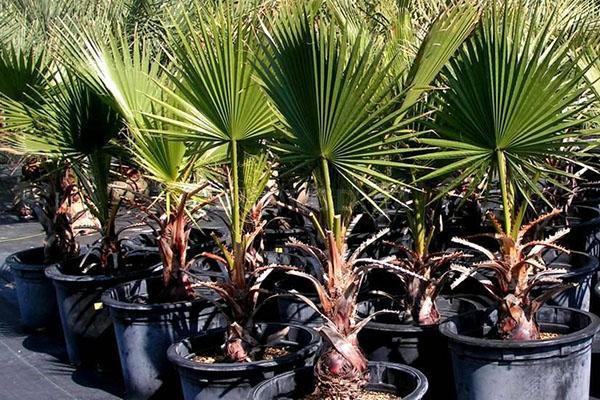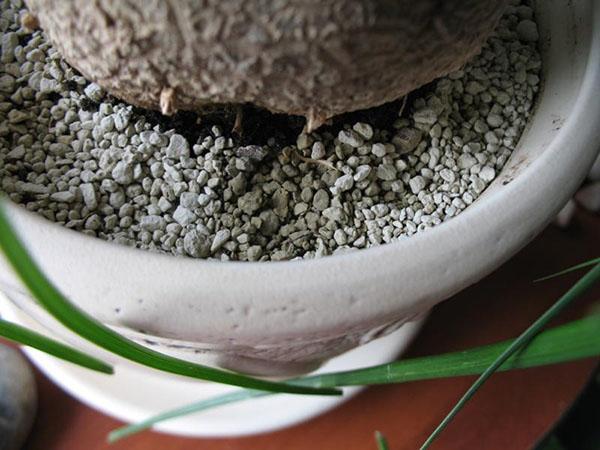Growing a palm tree at home: learning all the intricacies of a difficult craft
 Throughout the year, millions of people are attracted by ocean vacations. It is possible to create such an exotic environment on the floors if you correctly organize the cultivation of a palm tree at home. This includes the choice of pot, soil, and fertilizer. It is also worth considering the subtleties of transplantation, reproduction, and most importantly, the peculiarities of caring for a tropical plant.
Throughout the year, millions of people are attracted by ocean vacations. It is possible to create such an exotic environment on the floors if you correctly organize the cultivation of a palm tree at home. This includes the choice of pot, soil, and fertilizer. It is also worth considering the subtleties of transplantation, reproduction, and most importantly, the peculiarities of caring for a tropical plant.
Interestingly, the name Tamara means "palm". And ancient Jerusalem was called the city of these elegant trees. Therefore, to have such a flowerpot in the house is a special honor.
Growing a palm tree at home: everything from soil to care

There are 2 main types of plants: fan-leaved and pinnate. The first option is suitable for extraordinary design solutions, and the second - for more restrained, conservative ones.
Planting in a good substrate is the key to longevity
 Many people prefer to buy ready-made potting mixes from the store. Often it is used in its pure form when growing young seedlings. But true gurus of floriculture take this material only as a basis. They add many nutrients to it that stimulate the growth and development of the culture. The composition of such soil for a palm tree should include:
Many people prefer to buy ready-made potting mixes from the store. Often it is used in its pure form when growing young seedlings. But true gurus of floriculture take this material only as a basis. They add many nutrients to it that stimulate the growth and development of the culture. The composition of such soil for a palm tree should include:
- sand;
- peat (horseback in combination with lowland);
- expanded clay;
- dolomite flour;
- biohumus;
- mineral fertilizers.
 If there are no such ingredients in the purchased substrate, then you should think about its quality. In some cases, the best option would be to prepare the planting mixture yourself. It will include:
If there are no such ingredients in the purchased substrate, then you should think about its quality. In some cases, the best option would be to prepare the planting mixture yourself. It will include:
- The basis. Consists of clay-woody soil and deciduous soil humus. Each component is prepared in 2 parts.
- Drainage material. Use broken brick or expanded clay. Sand is added to all this (1 tsp). At the bottom, a mound of up to 3-5 cm is made, since the palm will have to be watered very often.
- Fertilizer. Of course, it will be peat and rotted manure. They are applied in equal amounts.
- Disinfector. Charcoal serves as such a tool, which needs 3-4 spoons.
All suggested ingredients create a nutrient medium that stimulates active growth. At the same time, the soil for a palm tree needs slightly acidic: within the range of 6.3-7.0 pH.
If it is not possible to buy the listed soil components, then they can be dug out in the garden or in the forest. However, before use, it is recommended to disinfect the earth: hold it in a water bath for 20 minutes, scald it with boiling water or treat it with a solution of potassium permanganate.
Balanced feeding
 You will need to fertilize the plant throughout its entire life cycle. It needs them when it reaches large dimensions. The frequency of introducing these: 2-3 times a month, and only in the spring and summer. For the winter, feeding is stopped (from November to March, the dormant period begins), thereby giving the plant a little rest. Before considering how to feed a palm tree, it is worth learning how to do it correctly. There are a number of rules:
You will need to fertilize the plant throughout its entire life cycle. It needs them when it reaches large dimensions. The frequency of introducing these: 2-3 times a month, and only in the spring and summer. For the winter, feeding is stopped (from November to March, the dormant period begins), thereby giving the plant a little rest. Before considering how to feed a palm tree, it is worth learning how to do it correctly. There are a number of rules:
- Mineral complexes are introduced only after watering. Wet roots are resistant to chemical attack.
- It is not recommended to carry out activities for the first 2 months after planting, since the soil contains enough nutrients. Although others advise to fertilize the palm tree as early as 14 days.
- Both root watering and spraying are used. Regarding the latter, it is important to know that with the slightest overdose, the leaves get burned. For 10 liters, take lime (2 g) and urea (10 g) either use a 2% superphosphate solution.
- The procedure is repeated every 10 days or once every 2 weeks.
- Organics are placed at the bottom of the pot together with peat and manure. They do this so that in the first years of life the roots do not reach the mixture.
- Fertilizers for palm trees are forbidden to use if the plant is sick. This only aggravates the course of the disease.
Nitrogen complexes should contain up to 50% of the main element, because it is simply not absorbed in small volumes. In other preparations, the phosphorus composition must be from 80%, otherwise the root system does not absorb it.
 Manure infusion is used as an organic top dressing for growing palm trees at home. It is collected in a container and filled with water so that the liquid covers the raw material. Keep in a cool place for 10 days, and then filter. The infusion is diluted in the following proportions: cow - 1: 5, and chicken - 1:10. Water with this solution only during the period of active growth.
Manure infusion is used as an organic top dressing for growing palm trees at home. It is collected in a container and filled with water so that the liquid covers the raw material. Keep in a cool place for 10 days, and then filter. The infusion is diluted in the following proportions: cow - 1: 5, and chicken - 1:10. Water with this solution only during the period of active growth.
Planning a transfer
 Change is an important milestone in plant life. Sometimes they are on schedule, and often they are unplanned. In this regard, it is important to know how to transplant a palm tree at home. Only the spring months are suitable for the event. Three-year-old seedlings need annual handling, and old-timers - every 3-5 years. In the latter case, the pot is simply broken or cut. At the same time, they try to carefully transfer the specimen to another container, cover it with earth and cover the soil with sphagnum moss.
Change is an important milestone in plant life. Sometimes they are on schedule, and often they are unplanned. In this regard, it is important to know how to transplant a palm tree at home. Only the spring months are suitable for the event. Three-year-old seedlings need annual handling, and old-timers - every 3-5 years. In the latter case, the pot is simply broken or cut. At the same time, they try to carefully transfer the specimen to another container, cover it with earth and cover the soil with sphagnum moss.
In adulthood, it is not recommended to transplant it. Therefore, you should periodically replace the top layer of the earth.
Some nuances of the process of transplanting and caring for a palm tree cannot be ignored either:
- the new container must be with a hole;
- the root system cannot be injured, much less cut off, it can end tragically;
- the transplanted exhibit is placed in the shade so that it takes root in the new environment;
- the height of the drainage layer is 3-5 cm;
- expanded clay is covered with manure, preferably horse manure;
- tropical guests are provided with frequent watering and spraying.
Palm pots are selected in small sizes. As a result, each year they have to be replaced with containers that will be larger than the previous ones. This cyclicality contributes to the uniform filling of the flowerpot with the rhizome.
A vital stage - reproduction
 Some varieties of exotic trees are grown from seeds. They are placed in warm water. They wait until they germinate, and then they are planted to a depth of 2-3 cm in the planting soil, the top layer of which is covered with sand. Planting is watered and covered with foil. After the emergence of seedlings, the "greenhouse" is removed. The container is placed in the light. After 2-3 months, the seedlings are dived into individual pots.
Some varieties of exotic trees are grown from seeds. They are placed in warm water. They wait until they germinate, and then they are planted to a depth of 2-3 cm in the planting soil, the top layer of which is covered with sand. Planting is watered and covered with foil. After the emergence of seedlings, the "greenhouse" is removed. The container is placed in the light. After 2-3 months, the seedlings are dived into individual pots.
The fastest way to reproduce a palm tree is vegetative. However, only special varieties allow root suckers. These varieties are called bush. A whole system of such a procedure has been developed:
- they are separated when they take root near the parent specimen, which means they form a powerful root system;
- conduct the event using a sterile sharp knife;
- the place of the cut is sprinkled with charcoal;
- sprouts are planted in a permanent place;
- cover with a glass cover or a tight bag.

Proper grooming is the highest degree of professionalism
The end result depends a lot on how you care for your palms. To begin with, the flowerpot must be placed on a spacious area, but not in the corner, because there is little space.So that the leaves do not turn yellow, the plant is provided with access to the sun - this can be the southwest side of the apartment. Daylight hours for him should last from 11 to 16 hours. Moreover, it is important to strive to recreate the natural habitat for its "beauty":
- temperature regime - 25-27 ° С, for varieties resistant to cold - 8-16 ° С;
- reliable protection against drafts and direct sunlight;
- high humidity, which is achieved by regular spraying (rain water can be used) or using a humidifier (40-50%);
- summer watering is carried out daily, and winter watering - once every 2 months;
- regularly cleaning the leaves from dust.
Every 14 days, the pot is turned or placed in a different place. Then all parts of the plant receive a sufficient amount of light.
Considering these factors, many put a flowerpot near a window with curtains. As a result, the scattered rays of the sun fall on the foliage. It is also important to know the technology of how to properly water a palm tree. To do this, use warm settled water. In some cases - a pallet filled with moss or expanded clay, filled with liquid. Always check the moisture level before the procedure. The soil should be 1/3 pot dry. However, it is important to avoid waterlogging.
 According to such a laconic scheme, palm trees are grown at home. Difficulties can arise only with the reproduction of culture. But the correct selection of soil, place, pot and microclimate will help to grow a luxurious tree.
According to such a laconic scheme, palm trees are grown at home. Difficulties can arise only with the reproduction of culture. But the correct selection of soil, place, pot and microclimate will help to grow a luxurious tree.
You cannot cut off the top of a palm tree, it will die. And what you have depicted, where you cut off the top, is not a palm tree but a dracaena. Dracaena never referred to palm trees.
Thank you for your attention. We have fixed the author's error.